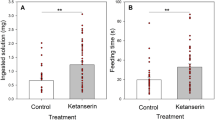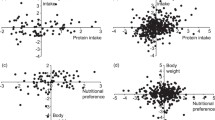Abstract
Animals, including insects, have the ability to self-select an optimal diet from a choice of two or more incomplete diets that lack an essential nutrient. This paper demonstrates that nymphs of the cockroach Rhyparobia madera also have this ability. The nymphs chose a protein:carbohydrate (P:C) ratio of approximately 25:75 when faced with a choice between one cube of protein (casein) and another of carbohydrate (sucrose). This self-selected ratio was shown to promote growth as well or better than other diets tested. When given a wide range of P:C choices, the R. madera nymphs consistently selected a P:C ratio of approximately 25:75, suggesting that they have the ability to diet-balance. Finally, injections of various serotonergic drugs into self-selecting nymphs influenced their choice of diets. Serotonin promoted a decrease in carbohydrate feeding, while injection of the antagonist α-methyltryptophan caused the nymphs to overfeed on carbohydrate. The results suggest that serotonin may help alter the carbohydrate feeding response in cockroaches.
Similar content being viewed by others
REFERENCES
Bernays, E. A., and Bright, K. L. (1993). Mechanisms of dietary mixing in grasshoppers: A review. Comp. Biochem. Physiol. 104A: 125–131.
Castonguay, T. W., and Collier, G. H. (1986). Diet balancing: Some limitations. Nutr. Behav. 3: 43–55.
Chambers, P. G., Simpson, S. J., and Raubenheimer, D. (1995). Behavioural mechanisms of nutrient balancing in Locusta migratoria nymphs. Anim. Behav. 50: 1513–1523.
Cohen, R. W., Heydon, S. L., Waldbauer, G. P., and Friedman, S. (1987). Nutrient self-selection by the omnivorous cockroach Supella longipalpa. J. Insect Physiol. 33: 77–82.
Cohen, R. W., Friedman, S., and Waldbauer, G. P. (1988). Physiological control of nutrient self-selection in Heliothis zea larvae: The role of serotonin. J. Insect Physiol. 34: 935–940.
Fernstrom, J. D., and Wurtman, R. W. (1971). Brain serotonin content: Increase following ingestion of carbohydrate diet. Science 174: 1023–1025.
Friedman, S., Waldbauer, G. P., Eertmoed, J. E., Naeem, M., and Ghent, A. W. (1991). Blood trehalose levels have a role in the control of dietary self-selection by Heliothis zea larvae. J. Insect Physiol. 37: 919–928.
Greenstone, M. H. (1979). Spider feeding behaviour optimises dietary essential amino acid composition. Nature 282: 501–503.
Hagele, B. F., and Rowell-Rahier, M. (1999). Dietary mixing in three generalist herbivores: Nutrient complementation or toxin dilution. Oecologia 119: 521–533.
Hamilton, R. L., and Schal, C. (1990). The influence of nymphal and adult dietary protein on food intake and reproduction in female brown-banded cockroaches. Entomol. Exp. Appl. 55: 23–31.
Overmann, S. R. (1976). Dietary self-selection by animals. Psychol. Bull. 83: 218–235.
Rozin, P. (1976). The selection of foods by rats, humans, and other animals. In Rosenblatt, J., Hinde, R. A., Beer, C., and Shaw, E. (eds.), Advances in the Study of Bahaviour, Vol. 6, Academic Press, New York, pp. 21–76.
Scriber, J. M., and F. Slansky, Jr. (1981). The nutritional ecology of immature insects. Annu. Rev. Entomol. 26: 183–211.
Simpson, S. J., and Simpson, C. L. (1990). Mechanisms of nutritional compensation by phytophagous insects. In Bernays, E. A. (ed.), Plant Insect Interactions, Vol. II, CRC Press, Boca Raton, pp. 111–160.
Slansky, F., Jr., and Wheeler, G. S. (1989). Compensatory increases in food consumption and utilization efficiencies by velvetbean caterpillars mitigate impact of diluted diets on growth. Entomol. Exp. Appl. 51: 175–187.
Thibault, L., and Booth, D. A. (1999). Macronutrient-specific dietary selection in rodents and its neural basis. Neurosci. Biobehav. Rev. 23: 457–528.
Waldbauer, G. P. (1968). The consumption and utilization of food by insects. Adv. Insect Physiol. 5: 229–288.
Waldbauer, G. P., and Bhattacharya, A. K. (1973). Self-selection of an optimum diet from a mixture of wheat fractions by the larvae of Tribolium confusum. J. Insect Physiol. 19: 407–418.
Waldbauer, G. P., Cohen, R.W., and Friedman, S. (1984). Self-selection of an optimal mix from defined diets by larvae of the corn earworm, Heliothis zea (Boddie). Physiol. Zool. 57: 590–597.
Waldbauer, G. P., and Friedman, S. (1991). Self-selection of optimal diets by insects. Ann. Rev. Entomol. 36: 43–63.
Wong, R. (1986). Caloric balancing and sucrose intake of hamsters and gerbils. Amer. J. Psychol. 99: 355–365.
Author information
Authors and Affiliations
Rights and permissions
About this article
Cite this article
Cohen, R.W. Diet Balancing in the Cockroach Rhyparobia madera: Does Serotonin Regulate this Behavior?. Journal of Insect Behavior 14, 99–111 (2001). https://doi.org/10.1023/A:1007805814388
Issue Date:
DOI: https://doi.org/10.1023/A:1007805814388




